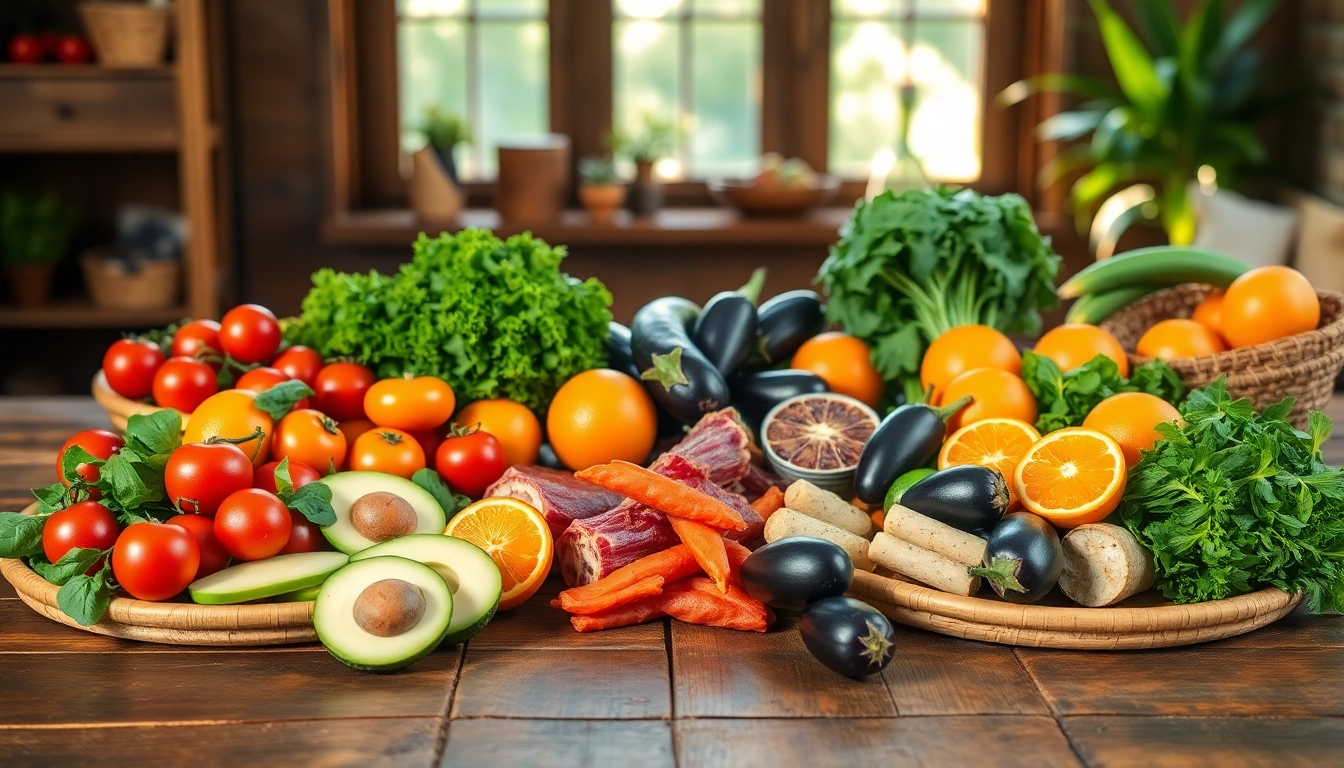Understanding Healthy Food: What Does It Mean?
Defining Healthy Food in 2024
In recent years, the definition of healthy food has evolved significantly. In 2024, healthy food encompasses a wide array of nutritional options that fuel our bodies, promote wellness, and support overall health. It isn’t just about avoiding unhealthy foods but includes actively choosing foods that provide essential nutrients. These foods are generally considered whole or minimally processed, rich in vitamins, minerals, fiber, and antioxidants. They should ideally be low in added sugars, unhealthy fats, and sodium. Healthy food is now being defined by its ability to enhance our metabolic health, mental clarity, and longevity, among other vital aspects of human life.
Benefits of Integrating Healthy Food into Your Diet
Integrating healthy food into your diet comes with a plethora of benefits, both physically and mentally. These benefits include:
- Improved Nutritional Profile: Healthy foods are often packed with essential vitamins and minerals, leading to overall better nutrition.
- Enhanced Energy Levels: Whole foods provide a steadier source of energy compared to processed foods, which can lead to energy crashes.
- Weight Management: Incorporating healthy foods, coupled with proper portion control, can help maintain a healthy weight or facilitate weight loss.
- Reduced Risk of Chronic Diseases: A diet rich in fruits, vegetables, whole grains, and lean proteins has been linked to a lower risk of heart disease, diabetes, and certain cancers.
- Mental Well-being: Foods rich in omega-3 fatty acids, antioxidants, and vitamins have been shown to improve mood and cognitive function.
- Better Digestive Health: A fiber-rich diet supports gut health, reducing the risk of digestive disorders.
Common Misconceptions About Healthy Food
Despite the increasing awareness about healthy eating, several misconceptions remain prevalent. Some of these include:
- Healthy Food is Expensive: Many believe that eating healthy necessitates high costs, but seasonally available produce and bulk buying can offset costs.
- All Fats Are Bad: Healthy fats, such as those found in avocados and nuts, are crucial for body function and should not be demonized.
- Healthy Eating is Not Satisfying: This belief underestimates the variety of flavors and textures available in healthy dietary options.
- You Must Eliminate All Junk Food: Healthy eating doesn’t require the complete banishment of all favorite treats; moderation is key.
Top Healthy Food Categories You Should Know
Fruits and Vegetables That Promote Wellness
Fruits and vegetables form the cornerstone of a nutritious diet, providing essential vitamins, minerals, and fiber while being low in calories. Some standout options include:
- Leafy Greens: Spinach, kale, and collard greens are nutrient-dense and provide considerable health benefits, including reduced inflammation and improved heart health.
- Berries: Blueberries, strawberries, and other berries are high in antioxidants, supporting brain health and reducing the risk of chronic diseases.
- Citrus Fruits: Oranges, grapefruits, and lemons are rich in Vitamin C and other antioxidants, bolstering immune function.
- Cruciferous Vegetables: Broccoli and Brussels sprouts contain compounds that have been linked to cancer prevention.
Whole Grains: The Backbone of Healthy Eating
Whole grains should form a fundamental part of your diet as they provide essential nutrients like fiber, B vitamins, and antioxidants. Consuming whole grains, such as:
- Quinoa: A complete protein containing all nine essential amino acids, quinoa is an excellent choice for vegetarians and vegans.
- Brown Rice: Higher in fiber and various nutrients compared to white rice, brown rice supports digestive health.
- Oats: Rich in beta-glucans, oats can reduce cholesterol levels and stabilize blood sugar.
- Barley: A fiber-rich grain high in vitamins and minerals that can improve heart health and aid digestion.
Lean Proteins: Healthy Food Choices for Stronger Bodies
Lean proteins are vital for muscle repair and overall health. Including a variety of protein sources, such as:
- Poultry: Chicken and turkey provide high-quality protein with less saturated fat compared to red meat.
- Fish: Particularly fatty fish like salmon and mackerel are rich in omega-3 fatty acids, which promote heart health.
- Legumes: Lentils, beans, and chickpeas are excellent sources of plant-based protein, fiber, and various essential nutrients.
- Nuts and Seeds: Almonds, walnuts, chia seeds, and flaxseeds are nutrient-dense snacks that provide healthy fats and protein.
Practical Tips for Incorporating Healthy Food
Shopping Smart: Finding Healthy Food at Grocery Stores
Shopping for healthy food begins with making informed choices at the grocery store. Here are some strategies:
- Plan Ahead: Create a shopping list based on healthy recipes to avoid impulse buys.
- Shop the Perimeter: Most healthy foods, like fresh produce, meats, and dairy, are often located around the store’s perimeter.
- Read Labels: Get into the habit of checking nutrition labels for added sugars, sodium, and unhealthy fats.
- Buy in Bulk: Purchase staple items, such as rice, beans, and frozen vegetables, in bulk to save money.
Meal Planning Strategies for Busy Lifestyles
For many, integrating healthy food into daily routines can feel daunting, especially with a busy lifestyle. Here are a few meal planning strategies:
- Batch Cooking: Prepare larger portions of meals and refrigerate or freeze for later use.
- Prep Ingredients: Wash and chop vegetables ahead of time to streamline cooking during the week.
- Use Simple Recipes: Choose recipes that require fewer ingredients and steps to make cooking less time-consuming.
- Incorporate Leftovers: Use leftovers creatively to create new meals, reducing waste and saving time.
Quick Recipes Featuring Healthy Food Ingredients
Healthy eating doesn’t have to be complicated. Here are some quick recipes to inspire your healthy meal prep:
- Quinoa Salad: Combine cooked quinoa, diced cucumbers, tomatoes, parsley, lemon juice, and olive oil for a refreshing lunch.
- Oven-Baked Salmon: Marinate salmon fillets in lemon juice and herbs before baking for a delicious and nutritious dinner in under 30 minutes.
- Stir-Fried Vegetables: Quickly sauté a mix of your favorite vegetables with olive oil, garlic, and soy sauce for a healthy side.
- Overnight Oats: Combine oats, milk (or plant-based alternative), and your favorite fruits in a jar for a quick, nutritious breakfast.
Challenges in Following a Healthy Food Diet
Overcoming Barriers to Eating Healthy Food
Despite the clear advantages of healthy eating, some barriers may hinder individuals. Common challenges include:
- Time Constraints: Individuals may feel too busy to cook or prepare healthy meals, resulting in convenience foods being the easier choice.
- Ingredient Availability: Not everyone has access to fresh produce or healthy food options, particularly in food deserts.
- Lack of Knowledge: Unfamiliarity with healthy cooking techniques and ingredients can be discouraging.
Overcoming these barriers requires fostering an understanding that minor adjustments can lead to significant changes. Seeking local resources like farmers’ markets, community-supported agriculture (CSA), or cooking classes can provide support.
Understanding Food Labels for Healthier Choices
One of the most useful skills for making healthy food choices is being able to read and understand food labels. Key elements to scrutinize include:
- Serving Size: Always check this to understand how the nutritional values correspond to the quantity you intend to consume.
- Calories: Helps you manage your total caloric intake effectively.
- Nutrients: Look for products high in vitamins, minerals, fiber, and proteins, while checking for low amounts of saturated fats, sodium, and sugars.
- Ingredients List: The shorter, the better. Aim for products primarily made from whole food ingredients.
Staying Motivated to Choose Healthy Food
Maintaining motivation to choose healthy foods can be challenging. Some tips to keep you on track include:
- Set Realistic Goals: Establish achievable healthy eating goals to avoid disappointment.
- Track Your Progress: Keeping a food journal can help visualize your journey toward a healthier lifestyle.
- Involve Friends and Family: Encourage communal cooking and shared meals to make the journey more enjoyable.
- Celebrate Small Wins: Acknowledge and reward yourself for sticking to your healthy eating habits.
The Future of Eating Healthy Food: Trends to Watch
Innovative Healthy Food Products 2024
The landscape of healthy food is constantly evolving with innovative products hitting the market. Trend predictions for 2024 include:
- Plant-Based Alternatives: As more people turn toward vegetarian and vegan diets, the market for plant-based meat and dairy alternatives is expected to surge.
- Functional Foods: These are foods fortified with additional nutrients or chemicals that provide health benefits, such as probiotics or omega-3 fatty acids.
- Clean Label Products: Consumers will demand transparency in what they consume, leading to a rise in products with minimal processing and recognizable ingredients.
Plant-Based Diets and Their Impact on Health
The plant-based diet continues to gain traction, with research linking it to numerous health benefits, including:
- Reduced likelihood of chronic diseases
- Better weight management
- Improvement in gut health
- Enhanced energy levels and mental clarity
Technology’s Role in Making Healthy Food Accessible
Technological advancements are crucial in making healthy food accessible. Key trends to watch include:
- Delivery Services: Meal kit and grocery delivery services can make healthy cooking more convenient.
- Mobile Apps: Nutrition and meal tracking apps help individuals stick to their eating goals by making the process engaging and informative.
- Online Communities: Social media platforms and forums now offer support, recipes, and encouragement to foster healthier eating habits.




